

Best Practices
Nonprofits
Your approach to volunteer management directly impacts retention. Learn the basics and best practices for effectively managing volunteers.


Volunteer management is the set of processes that organizations use to recruit, engage, and mobilize their on-the-ground and virtual volunteers. Effectively managing volunteers empowers your nonprofit to increase volunteer engagement, cultivate lifelong relationships, grow the impact of your events, boost revenue, and ultimately power your mission altogether.
However, many organizations tend to neglect several aspects of their programs and instead focus more heavily on recruitment, often because they feel they don’t have the capacity to make ongoing management a top priority.
Remember, your supporters are your organization’s greatest asset, and you want them to stick around! That means investing time and resources into those relationships upfront and ensuring every aspect of your program contributes to a positive experience for your supporters. Ultimately, investing in those relationships and empowering volunteers to drive your mission forward will repay dividends over time.
In this guide, we’ll walk through all the essentials you’ll need to orient your organization with volunteer management best practices. Here’s what we’ll cover:
At Mobilize, our goal is to help mission-driven organizations reach and engage supporters to make a difference in their causes. By making the right connections and then reinforcing them with the smart volunteer management strategies we share, you’ll build a strong foundation of support for your organization and its mission.

If your organization is new to developing concrete volunteer management strategies, you might be unsure of where to start. These frequently asked questions can give you a quick overview of the essentials, so you can start thinking about what to address in your own plans.
Any mission-driven organization that relies on supporters for virtual and in-person events or campaigns can benefit from implementing volunteer management strategies. These include nonprofit organizations, advocacy groups, political campaigns, labor unions, and more.
These groups can benefit from extra helping hands to help spread the word and make a difference in their cause. This includes everything from sharing marketing collateral online, to calling lawmakers to argue for or against a policy position, to helping set up and run events.
Volunteer managers are in charge of recruiting volunteers, assigning shifts and roles, implementing training programs, and supervising supporters as they carry out their responsibilities. They oversee the entire volunteer program and ensure that their organization is properly staffed for projects, events, and campaigns. Exact responsibilities vary by organization, but these are the basic duties that any volunteer coordinator holds.
In many ways, effective volunteer management practices are even more important for virtual campaigns and events to ensure the whole team is on the same page.
Plus, virtual organizing has become a major necessity for nonprofits, advocacy groups, political campaigns, and unions alike thanks to the substantial shift to online operations. With effective volunteer management software, you can train new supporters, mobilize them to take action for your cause, and tap into social media to grow your reach, all from a safe, virtual distance.
Effective volunteer management is vital because it helps build stronger long-term relationships with supporters and ensures the organization can make strides toward its mission.
While volunteers don’t typically contribute financially, their time commitment can be just as valuable. In fact, a study conducted by Independent Sector found that the value of a volunteer hour is $28.54. Not to mention, when actively managed and engaged, these supporters are also more likely to become donors and help you recruit others by sharing your mission.
That’s why so many nonprofits invest in their volunteer programs. Ongoing management and tools should improve the supporter experience, ensuring they’ll stick around long after the first activity they complete.
Simply put, supporters won’t feel much of a reason to stick around if you don’t prioritize their experience. Without a concrete plan in place for attracting, engaging, and retaining volunteers, they’ll likely have a poor experience when they show up to support your work.
A poor experience combined with minimal opportunities to drive your mission forward means that supporters are unlikely to stay engaged for very long. Similar to the higher cost of generating a new donor compared to re-converting an existing one — engaging an existing volunteer is less expensive and less intensive than generating a new one. That’s why volunteer retention should be prioritized whenever possible. Having concrete plans for creating a positive atmosphere, offering valuable activities, and actively measuring your program’s success are crucial for helping people feel compelled to stick around.

Each organization has its own unique goals, initiatives, and programs. As such, volunteer management can encompass a number of different elements depending on your organization’s exact needs and priorities.
However, there are a few critical components that are relevant in any volunteer program: recruitment, empowerment, communications, and recognition. These essential elements cover the entire engagement lifecycle, from attracting supporters to retaining their support and growing their involvement over time. Let’s take a look at each of these components.
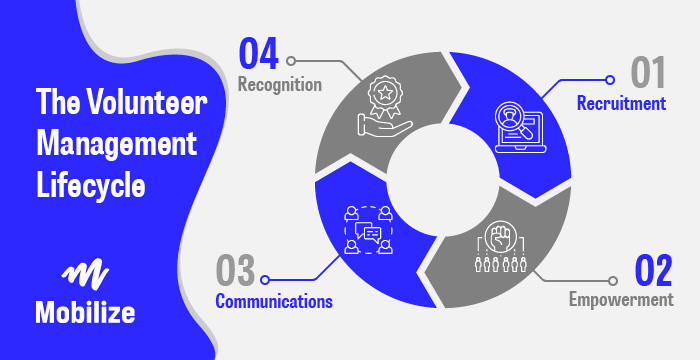
The first step to building out your program is to find volunteers who are ready and willing to serve. Determine what you need volunteers for — whether it’s a specific campaign, event, or project. Then, consider what information volunteers will need to jump on board. Develop job descriptions that answer:
The more information you can share with potential volunteers about your program, roles, and shifts, the more likely they’ll be to sign up. A volunteer recruitment platform like Mobilize can help immensely in this stage once you start publicizing your opportunities. Publish your volunteer opportunities and tap into a network of more than 4 million volunteers who are ready to serve and might not otherwise cross paths with your organization.
Not to mention, you can also leverage powerful peer recruitment tools where those who have signed up can promote the same opportunities to their friends. This helps you connect with likeminded individuals who are likely just as excited about the cause.
Empowering volunteers means that you need to place them in the right roles, which is why inquiring about skills or emphasizing desirable ones in your role descriptions are vital. Skills-based volunteering ultimately makes for a much more rewarding experience for everyone involved.
From here, you’ll want to offer plenty of training opportunities to help make sure volunteers are ready to go once their shift arrives. Bear in mind that different types of volunteering require different types of training, and this goes beyond the basic responsibilities they’ll have. For instance, virtual volunteer roles may require remote training opportunities, whereas in-person responsibilities can be taught in-person.
When they know exactly what they should be doing and they’re excited about it, they’ll feel fully empowered to do the best job they can.
At all stages in the volunteer management process, be sure to openly communicate with volunteers about their assignments. Remember, communication is a two-way street, especially when it comes to organizing volunteers.
To stay connected with volunteers both during and between jobs, develop a communications plan that allows you to share important information and updates with volunteers as well as gather and respond to volunteers’ questions and feedback.
Otherwise, you’ll wind up with lost volunteers who don’t quite know what they should be doing to be successful in the roles they’re assigned. Your volunteer tools will help centralize outreach, especially if you can automate tasks such as through automated reminders of upcoming shifts.
Any supporter should be rewarded for their hard work, especially your volunteers. If your volunteer management team takes a moment to express gratitude for the time people contribute, people will recognize that your organization truly values their skills and work ethic.
Here are a few simple ways you can recognize your volunteers:
Too many organizations focus their efforts on extensively thanking their donors, but forget about their volunteers. However you go about it, your volunteers deserve to be appreciated. After all, they’re giving up their free time to help your organization complete its work.

Volunteer opportunities come in all shapes and sizes. Offering a variety of engaging options for your audience is a smart way to maximize engagement over time and make sure there are plenty of opportunities to diversify their involvement.
As you build out your volunteer management plans, consider including some of these different types of roles that volunteers can fill.
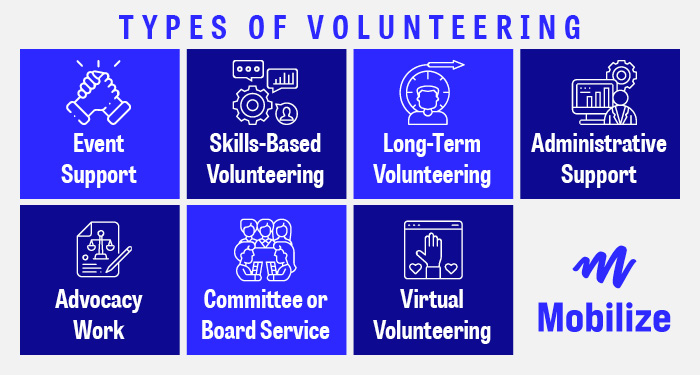
Chances are, you host several fundraising events each year to promote your cause and raise more funds. Volunteers can provide additional on-the-ground support to help keep things running smoothly. Event support might include activities such as set-up, guest registration, discussion facilitation, and merchandise sales.
Skills-based volunteers offer their services and expertise in-kind to nonprofits. This might include accounting, event planning, legal work, PR assistance, or digital marketing expertise. These people typically leverage these skills in their day jobs and can be helpful either on a one-off basis or throughout the duration of an ongoing project for your nonprofit.
Long-term volunteers have a committed, ongoing duty to serve the organization. These roles typically have set expectations and a designated time commitment that’s communicated from the start. Examples of this type of volunteering include youth mentors, tutors, coaches, and troop leaders.
Think of volunteers who offer administrative support as people who support your staff in the office. This might include activities like internal clerical work, data entry, or reception. These volunteers will likely be in the office quite a bit but won’t have a set commitment to the same degree as long-term volunteers.
Many organizations classify their nonprofit’s advocates as a specific type of supporter. However, they do contribute their time to your organization and they’re on the ground raising awareness for your cause, which means they fall into the volunteer role. This type of volunteer may have responsibilities like promoting your cause or campaign, securing petition signatures, or hosting discussion events.
Board and committee members serve a very important role in pushing your projects forward and making sure your organization stays on track. Committees are typically in charge of very specific tasks, such as event planning, whereas board members hold a dynamic range of responsibilities. Some of these include regularly attending meetings, deliberating the organization’s strategies, and voting on what decisions will put your organization on the best possible path.
This type of volunteer is exactly what it sounds like: they volunteer remotely. When supporters can’t physically gather to support your cause, it’s critical that they have ways to get involved and drive your mission forwardonline. Plus, it opens up your opportunities to much wider audiences geographically than you’d otherwise reach! Consider virtual opportunities for supporters to get involved, like:
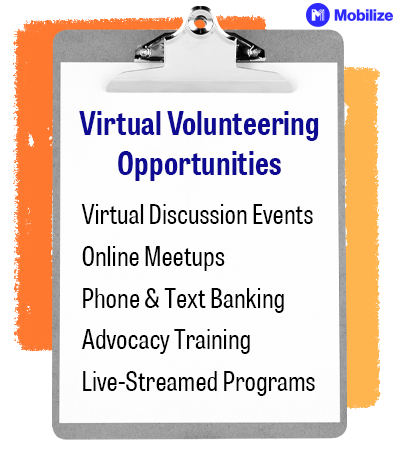
We can only expect this type of volunteering to stick around as the world becomes increasingly digital. Check out these creative virtual events we’ve seen organizations host, then start brainstorming unique online opportunities for your own organization!

Clearly, effective volunteer management can take your organization’s approach to supporter engagement to the next level. But how do you begin developing a concrete plan for continuously recruiting, managing, and retaining volunteers?
Let’s walk through the most effective volunteer management best practices. When combined with each other and adapted to fit your organization’s unique needs, each of these tips can help form a complete, start-to-finish plan.
Reach out to your existing pool of donors and supporters in the community, but look to additional outlets to reach even wider audiences whenever possible. For instance, the Mobilize.us platform allows organizations to tap into a rapidly growing network of more than 4.3 million dedicated volunteers looking for their next cause to support. Then, you can send updates via email, social media, text, and your website to reach each and every supporter.
By listing your volunteer opportunities on an online volunteer recruitment platform, you can direct existing supporters to your listing to register while also reaching new supporters. Then, encourage registered volunteers to share your event or campaign with their own networks of friends to supercharge your reach!
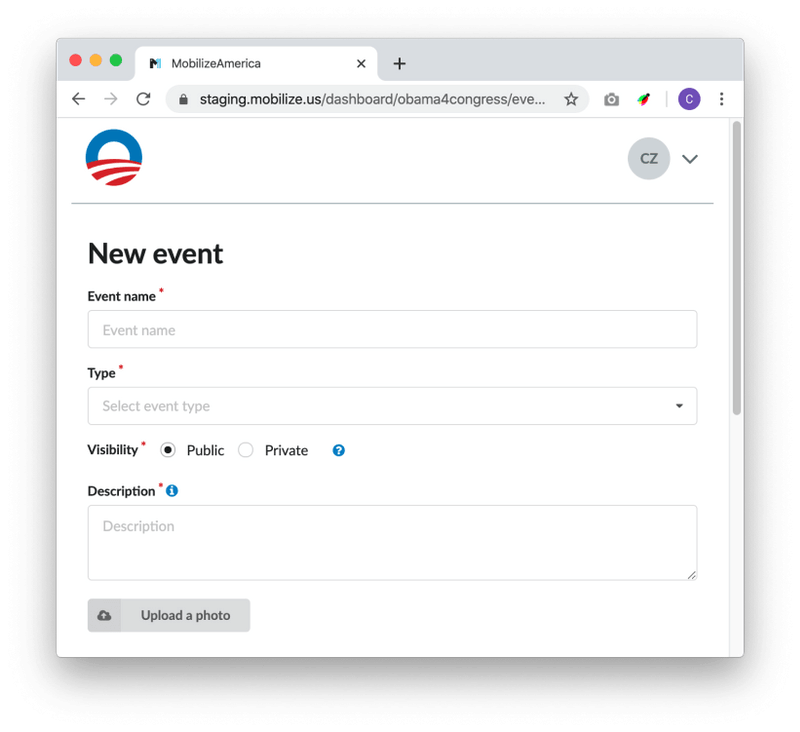
The registration process can make or break your volunteer recruitment efforts. A streamlined, convenient process will always secure more supporters for your event or campaign than a clunky one that takes too long or simply doesn’t work.
Whether you offer registration tools via a recruitment platform or directly on your organization’s website, ensure that the steps to sign up for your in-person or virtual opportunities take only a few minutes to complete. This will drive more sign-ups and ultimately generate more support for your cause.
Pro tip: Automate your email and text messages to registrants reminding them of upcoming events. This can be a game-changing strategy that drives more follow-through and engagement. Streamline this process by leveraging volunteer management software that includes automated communication tools—which we’ll cover more in-depth below.
As we mentioned, training is a crucial part of the volunteer management process. It helps volunteers understand what exactly they’re expected to accomplish. Think about it this way: you wouldn’t expect a new staff member to understand their duties without an onboarding process. Why would you expect that from a volunteer?
Sometimes requirement volunteers have specific skills or experiences can seem limiting or counterintuitive to building out your team, however this process of self-filtering helps volunteers choose roles that might be right for them. It also helps avoid volunteer attrition when they find out the role is significantly different than what they originally expected.
Create a straightforward orientation process that reviews the key responsibilities each position holds and emphasizes your nonprofit’s mission, policies, and volunteer guidelines. You might conduct this training on an individual level or at the start of a new volunteer initiative. Case in point, a successful onboarding process will help new volunteers get up and running quicker, so your nonprofit can start seeing results.
Retention is a critical part of any volunteer management strategy. When you retain volunteers from one fundraising campaign or event to the next, you strengthen your relationships with those supporters, leading to long-term support in the form of additional volunteering, donations, and more.
To start boosting retention, acknowledge your supporters for the critical roles they play in your organization’s success, and call out key individuals by name when appropriate. You might even host a special party, luncheon, or virtual celebration just to express your gratitude for all of their hard work.
Pro tip: Using dedicated volunteer management software makes it easy to track individuals’ engagement history with your organization. When they hit a certain number of volunteer hours, send personal thank you messages to show that you value every individual’s support.
As your organization begins retaining the support of volunteers across events, campaigns, and virtual opportunities, it’s important to define how you’ll keep them involved in your mission in your volunteer management plan.
Empower your most dedicated supporters to take the next step in driving your mission forward. Consider these volunteer management and engagement strategies:

Offering plenty of ways for volunteers to get involved and support your mission is an effective way to grow stronger relationships and sustain your organization over the long-run. Plus, simply offering more ways to engage increases the odds that every potential supporter finds the right opportunity for them!
Volunteer grants are a powerful way to bring more money to your cause. Double the Donation’s guide to corporate volunteer grants explains that “through these programs, companies provide monetary grants to organizations where employees regularly volunteer.” They usually contribute a set amount once their employee meets a minimum number of hours volunteering at an organization.
As part of your volunteer management practices, simply educate your volunteers on the process. All they have to do is check into their eligibility for their employer’s program and submit a request once they spend a certain number of hours working at your nonprofit. The company will then verify that the information given to them was correct with your team, then send a check to your organization.
Chances are, volunteers will jump at the opportunity, resulting in deeper engagement for them and more money for your nonprofit. After all, who wouldn’t want to multiply their impact on a worthwhile cause with a free financial contribution?
Finally, to cap off your volunteer management strategy and drive long-term success, you’ll need to actively steward the support of your volunteers.
This means expressing your gratitude, providing multiple ways to get involved, empowering them to deepen their impact on your mission, and developing a long-term plan to keep them engaged with updates and new opportunities. Automated communication will be your best bet for ensuring your organization stays on the minds of past and current volunteers. Plus, you can gauge their thoughts on how to get them even more involved and excited about your work through well-written surveys that inquire about their experiences.
Volunteer management software can play a vital role in shaping your stewardship strategies. With access to volunteer engagement data down to the personal level, it’s easier than ever to craft a plan for keeping supporters involved. Whether you’re looking at attendance records, the types of events people sign up for, or the roles they’re most interested in, your data can be a powerful indicator of how you can optimize the opportunities you offer to each volunteer and maximize the likelihood that they’ll show up. But what should you look for in a volunteer management platform? Our next section will take a deep dive into what features you should prioritize.


If your nonprofit, political organization, advocacy group, or union is new to volunteer management, it can be tricky getting your bearings when it comes to software. There’s a variety of platforms on the market geared towards organizations of all shapes and sizes.
However, there are key features to look for regardless of the type of organization you represent or the scale of your events or campaigns. Let’s take a look at what features will be most helpful when it comes to actively managing your volunteers.
Handling volunteer management, recruitment, and communication all through separate platforms will quickly become a logistical nightmare for your team. Whenever possible, combine key tasks into a single platform.
More comprehensive software won’t only simplify your work, but it’ll provide a more coherent, streamlined experience for supporters.
For instance, NARAL used the Mobilize suite of recruitment, management, and communication tools to centralize their organizing efforts and generate more engagement across the board:
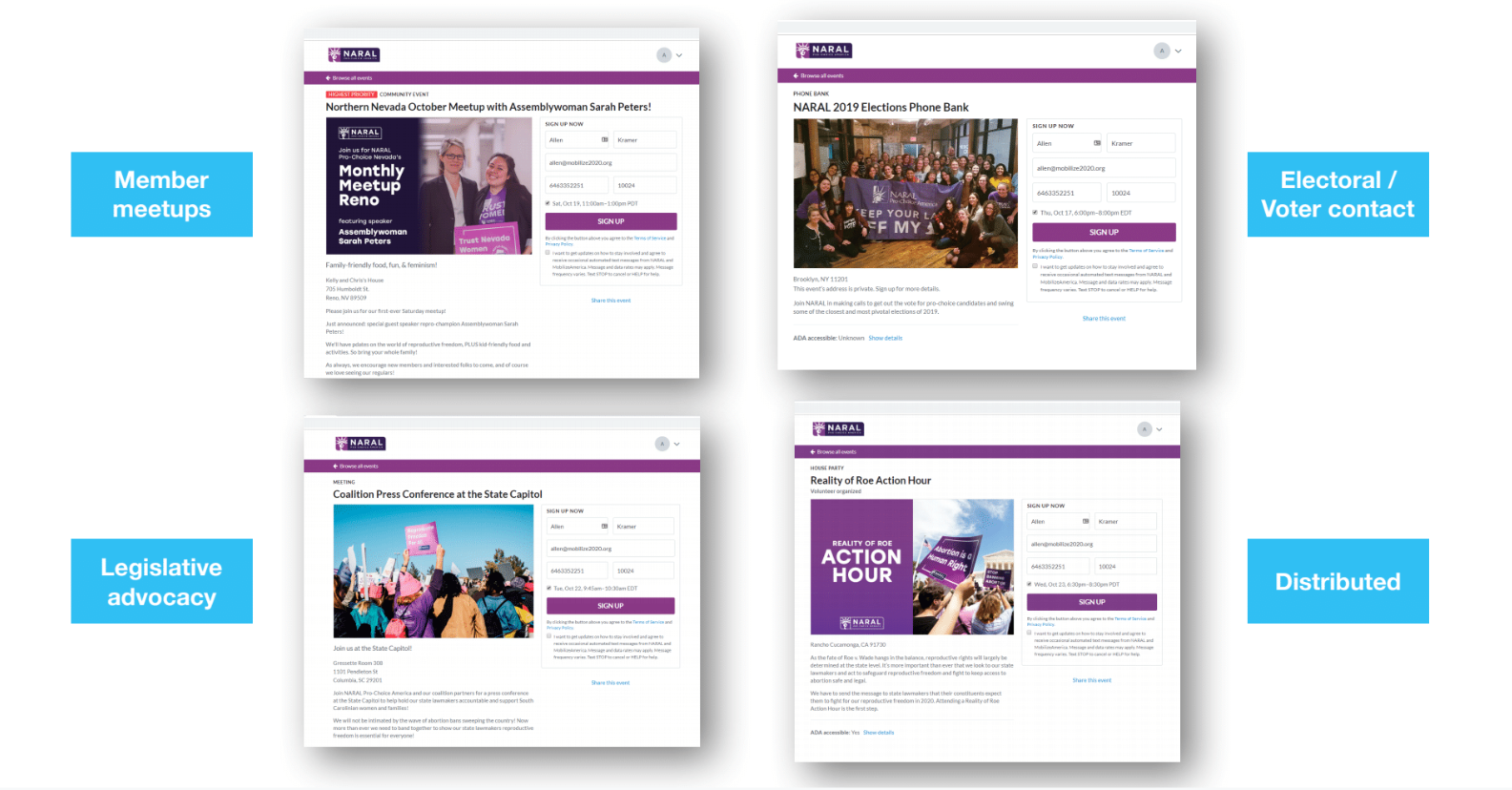
By handling all of their recruiting, event planning, communication, and peer-to-peer tasks within a single platform, NARAL saw an incredible 300% increase in monthly volunteer shifts and a 20% conversion rate on their shift sign-up forms.
Inspiring someone to volunteer can be challenging. Volunteer recruitment and registration tools eliminate this hurdle by connecting you with volunteers and providing a seamless signup process!
Quickly post multiple events, whether they’re single-shift or recurring, as well as virtual or in-person. Your volunteer opportunities will be put in front of our network of more than 4.3 million volunteers who are ready to support worthwhile causes like yours.
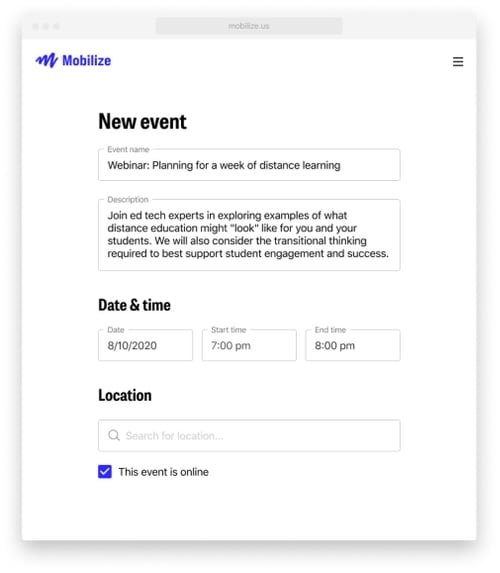
You can create a seamless sign-up process and start gathering volunteer applications right away thanks to:
Best of all, there’s no technical expertise required! Volunteer recruitment and registration has never been simpler thanks to optimized tools.
We’ve touched on communication automation a few times and for good reason! Automating emails and text messages to your registered volunteers can significantly boost engagement with your opportunities.
This is true both before and after your events and virtual opportunities. With Mobilize, automated reminder messages before initiatives have historically reduced no-shows by up to 30%. Plus, post-event surveys share invaluable insights into your volunteers’ experiences. In fact, on Mobilize, 32% of respondents share in-depth qualitative feedback. This is a powerful resource that can be used to refine your volunteer management strategies and develop even more valuable involvement opportunities for your mission.

For many types of volunteer events and opportunities, it can be difficult to field post-event feedback or comments from supporters who are fully focused on the activities at hand. Marches, protests, and live-streamed events are great examples of where this might happen. With volunteer management software that includes communication features, it’s easier than ever to fill these blind spots in your engagement strategy!
Access to your volunteer engagement data will be crucial for continuing to improve your strategies going forward. Look for software that provides a number of data reporting features, including:
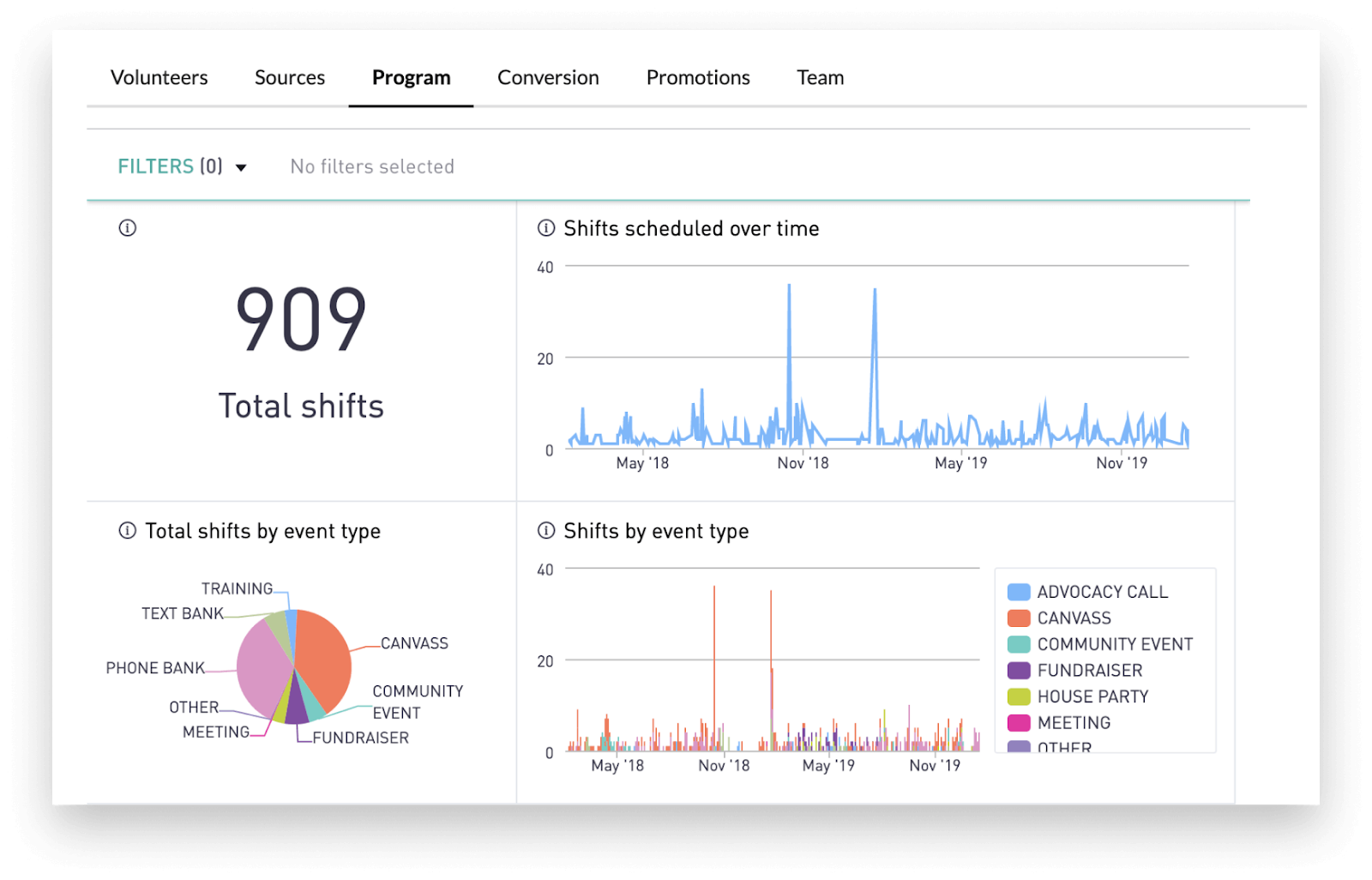
To really maximize the value of the data generated by your volunteer management software, look for platforms that integrate with your other systems, like your donation processing software, phone banking platform, or constituent relationship management (CRM) system.
A comprehensive view of your data allows your organization to continuously analyze your performance. Where is your volunteer management strategy succeeding? How can you better reach or engage supporters? What types of opportunities are specific supporters most interested in? Your data has the answers!
These are just a few of the main characteristics to look for in volunteer management software that can drive long-term value for your organization. Check out the Mobilize platform’s suite of tools and features for more examples of what to look for as you begin your research.


A concrete volunteer management strategy backed by effective software can take your organization’s events and initiatives to the next level. Reaching more supporters, getting them involved, and keeping them engaged with your work builds a solid foundation of support for your future projects.
With plenty of time for volunteer managers to test out new strategies, there’s constantly more to learn. Stay up-to-date on the latest trends and be proactive about learning more as you start developing your own volunteer management strategies! Kickstart your research and check out these great additional resources:


Best Practices

Best Practices

Best Practices